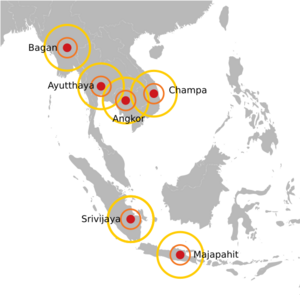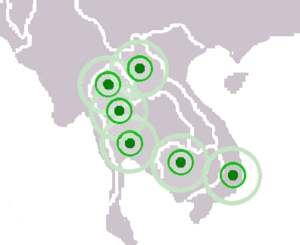Mandala (political model) facts for kids
The word Maṇḍala comes from Sanskrit and means 'circle'. In the history of Southeast Asia, a mandala was a special way to describe how power was spread out among different kingdoms or areas. This was especially true in medieval times, when local leaders had more power than a single central government.
Imagine a map where power isn't just in one big kingdom with clear borders. Instead, it's like a patchwork of circles, often overlapping. Each circle has a strong center, and its power spreads outwards. This idea helps us understand that these old kingdoms weren't like the countries we see on maps today, with fixed lines and a single government controlling everything.
Instead, a mandala was a group of kingdoms or areas that were connected. One main kingdom, called the "overlord," would have influence over smaller areas, called "tributaries." This system was a bit like the feudal system in Europe, where smaller lords were loyal to a greater lord.
Contents
What the Term Means
The word "mandala" is used because it reminds us of the mandala symbols in Hindu and Buddhist religions. These symbols show power spreading out from a center, like ripples in a pond. This comparison helps explain that the political system wasn't just about land, but about influence and connections.
Other ideas, like the "galactic polity" or "solar polity," also try to describe this system. The "galactic polity" suggests that kingdoms are like stars in a galaxy, connected but not rigidly controlled. The "solar polity" compares the main kingdom to the sun, pulling smaller kingdoms towards it like planets.
History of Mandalas
In history, some of the most powerful overlord states were the Khmer Empire (in what is now Cambodia), Srivijaya (in South Sumatra), and kingdoms like Majapahit (in Java). The Ayutthaya Kingdom in Thailand was also a major overlord.
These powerful kingdoms often received tribute from smaller states. Sometimes, even these big kingdoms would pay tribute to China, though China didn't usually demand much from them. Famous tributary states included Lan Xang (in modern-day Laos) and Lanna (in northern Thailand).
The mandala system started to change when Europeans arrived in Southeast Asia in the mid-1800s. Europeans had a different idea of countries, believing that every piece of land belonged to one ruler and had clear borders. As European powers like France, the Netherlands, and Britain colonized parts of Southeast Asia, they forced these fixed borders. This led to the end of the old mandala system.
The system also continued in some ways with the arrival of Islam. For example, the 18th-century Negeri Sembilan coalition in Malaysia was formed around a central area, with other districts connected to it.
Historians like Martin Stuart-Fox have used the term "mandala" to describe kingdoms like Lan Xang. They explain that these kingdoms were made of many smaller areas that were loosely connected.
What Were the Obligations?
The rules between an overlord and a tributary state could change. It depended on how strong their connection was and what was happening at the time.
Generally, a tributary state had to pay bunga mas. This was a regular payment of valuable goods, like gold and silver trees, or even people. In return, the overlord ruler would often give gifts that were even more valuable than the tribute.
Tributary states also had to provide soldiers and supplies if the overlord needed them, especially during wars. The main benefit for the tributary was protection from other powerful kingdoms. However, sometimes this protection was from the overlord itself!
The overlord usually didn't interfere much with the tributary's internal affairs. The tributary could keep its own army and collect its own taxes. In some cases, the "overlord" might see the relationship as tribute, while the "tributary" might just see it as trading gifts or showing friendship.
Personal Relationships Were Key
One very important part of the mandala system was the focus on personal relationships. A tributary ruler was loyal to the overlord ruler as a person, not just to the overlord's kingdom.
This meant that a strong overlord ruler could attract more tributary states. A weaker ruler might find it hard to keep these connections. For example, the Sukhothai kingdom grew very quickly under Ram Khamhaeng the Great because he was a strong leader. But it declined just as quickly after he died because the personal connections weakened.
A tributary ruler could also choose to end the relationship and find a different overlord, or even become completely independent. The system wasn't about controlling land. It was about loyalty between rulers. The overlord had power over the tributary ruler, or over the main town of the tributary, but not necessarily over every person in a specific area.
For example, the relationship between Dharmasetu of Srivijaya and Samaratungga of Sailendra showed this. Dharmasetu was the main ruler, and Samaratungga's family was connected to Srivijaya. When Samaratungga married Dharmasetu's daughter, he became the next ruler. This even shifted the center of Srivijaya's power from Sumatra to Java for a while.
Not Always Exclusive
The relationship between an overlord and a tributary was not always exclusive. A state located in a border area might pay tribute to two or even three stronger powers at once.
This allowed the tributary ruler to play the stronger powers against each other. This helped them keep their independence and minimize interference from any one overlord. For the major powers, these shared tributary states acted like a buffer zone. They helped prevent direct conflicts between the big kingdoms.
For instance, early Malay kingdoms in the Malay Peninsula like Langkasuka and Tambralinga were first part of the Srivijayan mandala. Later, both the Ayutthaya and Majapahit mandalas tried to control them. Eventually, the Malacca Sultanate became strong enough to be its own center of power.
See also
- Indianisation - how Indian culture spread in Southeast Asia
- Sanskrit-related topics - words and ideas from Sanskrit
- Chakravartin - a concept of a universal ruler
- Devaraja - the idea of kings being like gods in Southeast Asia
- Greater India - areas influenced by Indian culture
- History of Indian influence on Southeast Asia - how Indian ideas spread
- Indian influences in early Philippine polities - Indian influence in early Philippine kingdoms
- Indian maritime history - how sea travel helped spread ideas
- Indosphere - the region influenced by Indian culture
- Similar ideas elsewhere
- General
- Palace economy - how ancient governments managed resources
- Political geography - how geography affects politics
- Sacred king - kings who are seen as having a special, holy meaning
- Sphere of influence - an area where one country has special power
- Suzerainty – when one state controls another's foreign policy but allows it to rule itself
- Zomia (geography) - a term for remote, independent areas



